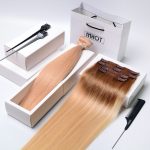At some point, almost every woman is going to contemplate her hair weave options. Hair weave, also commonly referred to as hair extensions, comes in many styles. Today there are also lots of different ways to attach hair weave, which can affect the cost, appearance, and longevity of extensions.
Consider this your hair weave crash course. By the time you are done reading you will be familiar enough with all the weave basics to schedule an appointment with your stylist!
Real vs. Synthetic Hair
The first decision you will need to make is whether you want real (human) or synthetic hair. There are pros and cons to each:
Real hair weave is going to blend the best, offer the most versatility, can be dyed to match your hair, heat styled, and washed like normal hair. The trade off is that the extensions will only last about 2-6 months and they tend to be more expensive. You will also need to care for real hair weave the same way you current for your own hair.
Synthetic hair weave is cheaper than real hair and easier to maintain. New fiber materials have also made synthetic hair much closer to the look and feel of real hair. Synthetic hair has a “built-in” style, which can be beneficial, however you may be limited in terms of switching up the styling. It is easier but not as versatile.
You have to be careful when you are buying hair weave online or you might pay real hair prices for synthetic extensions. Look for products like Lumibloom weaves that specify exactly where the hair was sourced to avoid this problem.
Virgin vs. Processed Hair
For all those lovely ladies that want real hair extensions you have another choice to make: virgin or processed hair. Virgin hair is untouched. It has not been processed or dyed. Because of this, virgin hair is popular and tends to be more expensive. If you are trying to color match your hair perfectly, virgin hair is the only way to go.
Processed hair has been stripped of its original color and dyed. It can also be processed to give the hair texture. Depending on the processing technique used, the quality and durability of the hair could be affected. The upside is processed hair tends to be cheaper.
Finding the best virgin hair companies can take time. You have to trust that the company is true to their word about the condition of the hair.
Attachment Technique
If you are new to extensions you may feel a little overwhelmed when you research the different techniques for attaching the hair. It may take time, but it is one of the most important decisions when you are picking the best hair extensions.
Clip-in Extensions: Least expensive, least commitment, temporary. Wefts of hair weave with clips at the top can be clamped onto hair at the roots for added fullness.
Hot Fusion/Keratin Bond: Semi-permanent, strand-by-strand technique, longest lifespan, very expensive. Groups of 20-30 strands with keratin u-tip silicon bonding on one end are affixed to hair using a heat tool.
Cold Fusion: Semi-permanent, strand-by-strand technique, long lifespan, very expensive. Groups of 20-30 strands have a small bead at the end that natural hair is pulled through. Using a specialized tool, the stylist clamps the bead to attached it to the natural hair without heat.
Glue In: Temporary, inexpensive, removable, can cause damage. If you only want hair extensions for a few days to a week, then the glue in technique will work. The stylist applies glue to the top of the weave weft and fixed to the hair.
Tape In: Semi-permanent, suitable for fine hair, reusable extensions, price varies. The tape in technique is popular since it is quick to apply the 2-4” wide wefts and is less likely to damage your hair. The wefts are applied using single or double-sided polyurethane tape.
Sew In: Semi-permanent, inexpensive, no heat or glue, suitable for curly hair. The traditional way to attach weave to thick and/or coarse hair is the sew in method. First, your hair is braided tightly against the head, then the weave is sewn into the braids with needle and thread.
Micro-Link Skin Weft: Less damaging to hair, quick attachment, can be expensive, and maintenance needed every 4-6 weeks. Special tool and extension wefts clamp weave to existing hair strands.
Hair/Weft Weight
Once you have decided on the type of hair and attachment technique you want to use, you will need to consider the hair/weft weight. The weight (thickness) of the weave is influenced by the hair strands themselves as well as the number of hairs added to each weft. Usually, the thicker the hair or weft is the more it’s going to cost. However, you may need fewer wefts if there is more weight to it so the cost may balance out.
Extension Length
Last but not least, is weave length. Extensions come in standard lengths, but can be cut so that they blend with your hair. You can commonly find hair weave in 10”, 12”, 16”, 18”, 20”, and 22” lengths. Essentially, the longer the extensions are the more expensive they are going to be.







